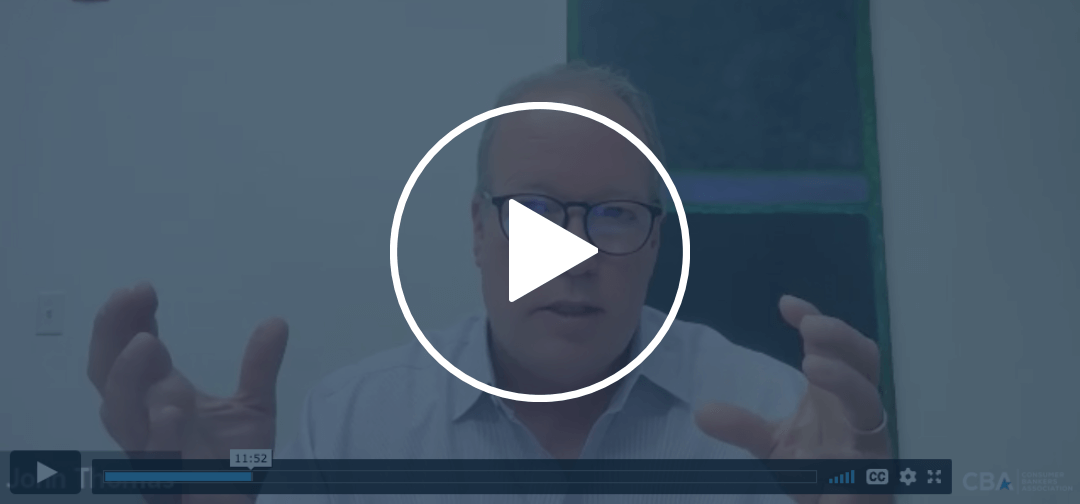Relay recently hosted a webinar with CBA, “Humanizing the Digital Experience: Successes and Insights from a Career Innovator”, featuring John Thomas, former EVP of Global Innovation at TD Bank and current Chief Strategy Officer at Relay Network. Given his vast experience at both tech and financial services firms, Thomas has a unique perspective on how banks can modernize their customer experience using learnings from the tech world.
Throughout the webinar conversation, facilitated by Tricia Gabberty, CEO of Darkhorse Consulting, Thomas shares practical insights to help any bank or credit union embark on their journey toward humanizing digital customer engagement. Below are some highlights from the conversation, but if you are interested in listening to the full webinar, you can click the image above.
On data and how to use it effectively:
Data is at the center of humanizing digital experiences. However, legacy infrastructures exist in both the data systems and the channel side, which can cause issues when trying to use the data and deliver it across various channels. Thomas’s advice is to simplify.
Don’t try to solve everything right out of the gate or reinvent the wheel. Thomas says, “take the data in whatever format and frequency you can get it out of your vendors and your systems, send the data or send the recommendation to your channels in whatever format and frequency they can handle.”
And most financial services institutions have campaigns that they already send out to customers. Thomas says to start with those but think about the different modalities that those campaigns are feeding and see if there is an opportunity to try something new: “They’re probably feeding email or direct mail or maybe something in your app, so begin to think about triggering that same thing into a scrolling digital interface.”
Thomas points out an opportunity here to modernize the engagement mechanism that banks and credit unions use to connect with customers to meet them where they are in their digital maturity.
On how financial services institutions think about asymmetry in business:
When it comes to competition with financial services institutions, Big Tech is where the asymmetry lies. Thomas clarifies for the audience, “I’m talking about those big marketplace, search, phone, digital companies in the world that are increasingly encroaching on financial services space, and there is an asymmetry at work when you’re thinking about competing with those.”
One of the areas that financial institutions may see the greatest asymmetry to Big Tech is in data. Banks and credit unions deal primarily with demographic and transactional data, while Big Tech has preference and intent data. Both have a predictive nature to them; however, as Thomas notes, “while the banking dataset is predictive, what I did six months ago or six weeks ago is somewhat predictive of what I’m going to do six hours from now. But what I searched for recently (referring to the intent data) is infinitely more predictive of what I’m going to do six hours or six days from now.”
A more attainable area that financial services can work toward competing with Big Tech today is in the interface by which they are interacting with customers. Thomas notes, “Digital interactions now are dominated by your finger on a phone scrolling through content. Every single Big Tech company has scrolling interfaces. Financial service’s answer to that has been web portals and apps with hamburger menus.”
By shifting to a more flexible interface that customers interact with on a regular basis, financial services organizations can equalize the playing field with Big Tech. Thomas notes, “And I think that’s part of how we can begin to fight that asymmetrical battle a little bit with Big Tech because the battlefield on the data and the PE ratio side is stacked against financial services. But where I think banks and credit unions can win is on the interface.”
On the importance of customer obsession:
Thomas notes that he is fortunate to work for companies that always put customers at the center of their strategy. But that is not the case everywhere. To start building that customer-obsessed culture, Thomas shares a practice that he believes will drive that action. He says, “when you get into the conference room and you’re debating some hard decision or some investment or some priority list, I’m a big fan of putting customer data in the middle of the table. No matter what level you’re dealing with inside of your bank or credit union, it’s very hard in a meeting when you put customer information in the middle of the table to ignore it.”
By literally putting the customer in the middle of the table, it forces the conversation to focus on what the customer needs and how to strategize around it as an organization. Thomas shares many more insights throughout the conversation, so if you would like to listen to or watch the full webinar, please click here.
If you are interested in learning about using a scrolling interface to engage with your customers, reach out to us here at Relay to learn about our engagement solution, the Relay Feed.
